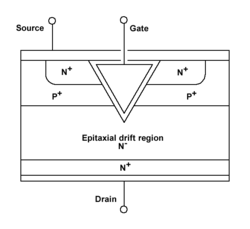VMOS

A VMOS transistor is a type of metal oxide semiconductor transistor. Vmos is also used to describe the V-groove shape vertically cut into the substrate material. VMOS /ˈviːmɒs/ is an acronym for "vertical metal oxide semiconductor", or "V-groove MOS".[1]
The "V" shape of the MOSFET's gate allows the device to deliver a higher amount of current from the source to the drain of the device. The shape of the depletion region creates a wider channel, allowing more current to flow through it.
This structure has a V-groove at the gate region and was used for the first commercial devices.
The device was used as a power device until more suitable geometries, like the UMOS (or Trench-Gate MOS) were introduced in order to lower the maximum electric field at the top of the V shape and thus leading to higher maximum voltages than in case of the VMOS.
VMOS was invented by T. J. Rodgers while he was a student at Stanford University. See T._J._Rodgers#Patents 1975-1980.